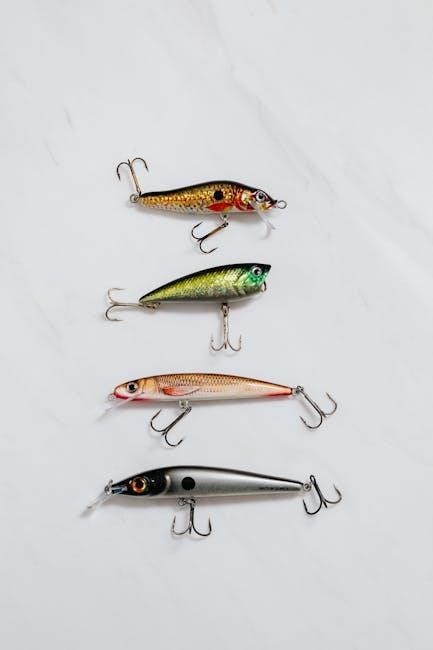Choosing the right treble hook size is a critical decision for anglers‚ as it directly impacts fishing success and the well-being of the fish. Treble hooks‚ with their three distinct points‚ are widely used on artificial lures such as crankbaits‚ spinners‚ and spoons. However‚ selecting the appropriate size can be challenging due to the variety of options available‚ ranging from small size 12 or 14 hooks to larger 2/0 hooks.
The size of the treble hook should match the size of the bait or lure being used‚ ensuring that the hooks do not overly dominate the presentation. For example‚ smaller hooks are ideal for delicate baits or when targeting panfish‚ while larger hooks are better suited for big lures and larger species like bass or pike. Additionally‚ factors such as the type of fishing (ice fishing‚ freshwater‚ or saltwater) and the behavior of the target species play a significant role in determining the optimal hook size.

Understanding treble hook sizes is essential for maximizing hooking efficiency and minimizing the risk of losing fish. This guide will help anglers navigate the complexities of treble hook sizing‚ ensuring that their tackle is appropriately matched to their fishing conditions and goals.

Factors Influencing Treble Hook Size
Choosing the right treble hook size is not a one-size-fits-all decision. Several factors influence the selection process‚ and understanding these elements is crucial for anglers to maximize their fishing efficiency and success. Whether you’re a seasoned angler or a beginner‚ considering these factors will help you make informed decisions about which treble hook size to use in various fishing scenarios.
Bait or Lure Size

One of the most significant factors influencing treble hook size is the size of the bait or lure being used. A treble hook that is too large can overwhelm the bait‚ making it less attractive to fish and potentially causing it to swim or move unnaturally. Conversely‚ a hook that is too small may not hook larger fish effectively‚ leading to missed opportunities or lost catches. For example‚ smaller treble hooks (e.g.‚ size 12 or 14) are ideal for delicate baits like small spinners or jigs‚ while larger hooks (e.g.‚ size 2 or 4) are better suited for bulky lures such as crankbaits or spoons.
Target Species
The species of fish you are targeting also plays a critical role in determining the appropriate treble hook size. Different fish have varying mouth sizes and behaviors‚ which affect how they interact with the hook. For instance‚ when fishing for smaller species like trout or panfish‚ smaller treble hooks are typically more effective‚ as they are less likely to cause injury or deter bites. On the other hand‚ larger species like pike‚ bass‚ or walleye require sturdier hooks to ensure a secure hold and prevent the hook from bending or breaking under pressure.
Hook Type and Design
The design of the treble hook itself can also influence the size selection. For example‚ barbed hooks are designed to hold fish more securely once hooked‚ but they can cause greater injury to the fish. Barbless hooks‚ while more fish-friendly‚ may require a slightly larger size to compensate for the lack of a barb. Additionally‚ some treble hooks feature unique designs‚ such as inline hooks or short-shank hooks‚ which may affect their effectiveness in specific fishing scenarios. Understanding the pros and cons of different hook designs can help anglers choose the most appropriate size for their needs.
Fishing Technique
The fishing technique being employed is another important factor in selecting treble hook size. For example‚ in ice fishing‚ where smaller baits like maggots or minnow heads are often used‚ smaller treble hooks are typically preferred to avoid deterring bites from smaller species like perch or walleye. In contrast‚ when trolling or casting large crankbaits in open water‚ larger treble hooks are necessary to handle the force of the presentation and the strength of the target species. The speed and depth at which the lure is fished can also influence hook size‚ as faster-moving lures may require sturdier hooks to withstand the stress of retrieval.
Regional Fishing Regulations
Fishing regulations in specific regions or waterways can also impact treble hook size selection. Many areas have restrictions on the minimum or maximum hook size allowed‚ as well as whether barbed or barbless hooks are permitted. These regulations are often implemented to protect fish populations and ensure sustainable fishing practices. Anglers must familiarize themselves with local rules and guidelines to avoid legal issues and contribute to conservation efforts. For example‚ some regions may require the use of barbless hooks to reduce fish mortality rates‚ which may necessitate adjusting the hook size to ensure effective hooking.

Angler Preference and Experience
Finally‚ personal preference and experience also play a role in choosing treble hook size. Veteran anglers often develop a keen sense of which hook sizes work best for specific lures and fishing conditions based on trial and error. For newcomers to fishing‚ experimenting with different hook sizes and observing their performance can help build confidence and improve results over time. It’s important for anglers to stay flexible and willing to adjust their hook size based on the feedback they receive from their fishing experiences.
